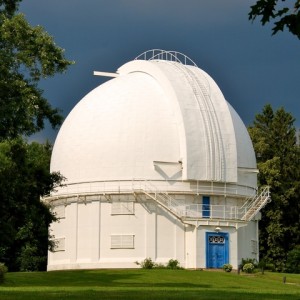March – August 2012
Gravity: From Falling Apples to Ripples in Spacetime

SpEC binary black hole simulation – Image Credit: Harald Pfeiffer (CITA)
April 5th, 2012, 9:10pm
Speaker: Ilana MacDonald
Location: MP 102, 60 St. George street
Sign up for the Planetarium Show!
The force of gravity is something that each and every one of us experiences all the time. It’s what keeps us from flying into space off the surface of the earth, and what keeps the planets in orbit around the sun. In this talk, we shall explore the concept of gravity, starting with humanity’s earliest theories about how the this force works and ending with my current research on the ripples in space-time caused by inspiralling binary black holes. We will discuss the theories of the ancient Greek philosopher Aristotle, the renaissance scientists Copernicus, Galileo, and Kepler, and the revolutionary physicists Newton and Einstein. We will see that the evolution of the concept of gravity is closely tied with the history of science and astronomy.

Ilana MacDonald is a PhD candidate in the fourth year of her doctoral studies in the Department of Astronomy and Astrophysics at the University of Toronto. With her supervisor Prof. Harald Pfeiffer of CITA, she studies the gravitational waves, that is, ripples in space-time, given off by binary black holes. She is also very involved in Astronomy public outreach at UofT, helping organize public lectures, and giving planetarium shows to the public. In her spare time, she enjoys knitting and riding her e-bike all around the city (though not at the same time).
(Content taken from http://www1.astro.utoronto.ca/~gasa/public_talk/iWeb/Entries/2012/4/gravity.php)
In April, the club plans to organize a visit to the David Dunlap Observatory. With the telescope housed there, Toronto astronomer Tom Bolton confirmed the existence of the first black hole, called Cygnus X-1! It’s going to be awesome.
(We hope to organizer a caravan of cars departing from Huron at 6pm. DDO staff will guide on a tour and tell us about the telescopes and more between 7pm and 9pm.)
A visit to the David Dunlap Observatory!
In April, the club plans to organize a visit to the David Dunlap Observatory. With the telescope housed there, Toronto astronomer Tom Bolton confirmed the existence of the first black hole, called Cygnus X-1! It’s gonna be awesome. (Photograph by John Goodyear.)
 Please RSVP by clicking here and filling out the form.
Please RSVP by clicking here and filling out the form.
April 21, 22 – Lyrids Meteor Shower. The Lyrids are an average shower, usually producing about 20 meteors per hour at their peak. These meteors can produce bright dust trails that last for several seconds. The shower usually peaks on April 21 & 22, although some meteors can be visible from April 16 – 25. With no moon to get in the way this year, this really should be a good show. Look for meteors radiating from the constellation of Lyra after midnight.
May 5, 6 – Eta Aquarids Meteor Shower. The Eta Aquarids are a light shower, usually producing about 10 meteors per hour at their peak. The shower’s peak usually occurs on May 5 & 6, however viewing should be good on any morning from May 4 – 7. The full moon will probably ruin the show this year, washing out all but the brightest meteors with its glare. The radiant point for this shower will be in the constellation Aquarius. Best viewing is usually to the east after midnight, far from city lights.
What is Science Rendezvous Science rendezvous is a free, all-day science festival, experiencing its 5th consecutive event across the GTA on May 12, 2012. Science rendezvous aims to highlight and promote science in all its aspects, with the ultimate goal of improving student enrollment and public investment in science and technology in the future. Science Rendezvous showcases the best and brightest in science and technology in Canada. The public will get a chance to meet with world-class researchers, take a behind the scenes tour of some of the cutting-edge research labs, participate in hands on experiments and activities, watch amazing demonstrations of the integration of science, architecture and human ingenuity, and most of all, have fun while experience science in a whole new way! This one-day event will make science accessible to people of all ages and from all back-grounds. This year at UofT, we expect over 10,000 attendees to come on May 12th!
https://sr.escalator.utoronto.ca/home/
June 5, 6 – Transit of Venus Across the Sun. This extremely rare event will be entirely visible throughout most of eastern Asia, eastern Australia, and Alaska. A partial transit can be seen in progress at sunrise throughout Europe, western Asia, and eastern Africa. A partial transit can be seen in progress at sunset throughout most of North America, Central America, and western South America. The next transit will not take place until the year 2117. (NASA Transit Information | NASA Transit Map)
August 6 – Curiosity Rover at Mars. NASA’s Mars Science Laboratory (MSL) is scheduled to land on the red planet between August 6 and August 20, 2012. Officially named Curiosity, it is an autonomous rover similar to the Spirit and Opportunity rovers that previously visited Mars. This much larger rover will carry many more instruments and experiments than its previous cousins. Curiosity’s high definition color cameras will photograph the Martian surface while a host of instruments will sample the soil and air and search for organic compounds.

 Agenda
Agenda
 Day
Day
 Month
Month
 Week
Week
